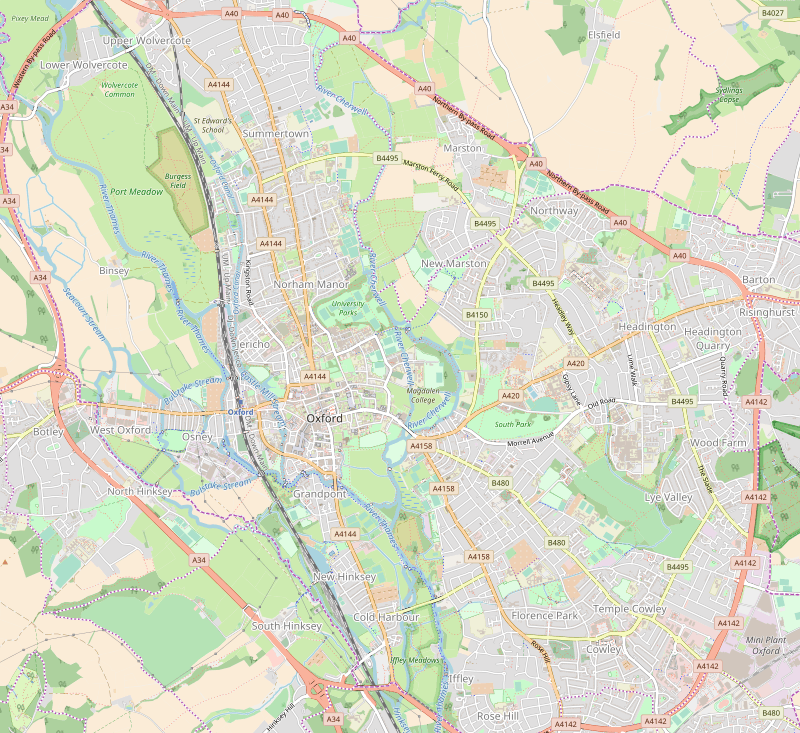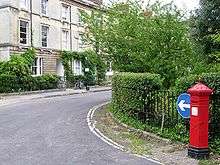Park Town, Oxford
Park Town is a small residential area in central North Oxford, a suburb of Oxford, England. It was one of the earliest planned suburban developments in the area and most of the houses are Grade II listed.[1]
| Park Town | |
|---|---|
The main crescent of Park Town | |
 Park Town  Park Town Location within Oxfordshire | |
| OS grid reference | SP512078 |
| Civil parish |
|
| District | |
| Shire county | |
| Region | |
| Country | England |
| Sovereign state | United Kingdom |
| Post town | Oxford |
| Postcode district | OX2 |
| Dialling code | 01865 |
| Police | Thames Valley |
| Fire | Oxfordshire |
| Ambulance | South Central |
| UK Parliament | |
| Website | Oxford City Council |

History and overview
Samuel Lipscomb Seckham (1827–1900) developed the houses in the main crescent in 1853–54, with Bath stone front elevations, and the west-facing crescent with an elevated pavement known as "The Terrace" in 1854–55. The Park Town Estate Company was formed in September 1857 through Seckham's efforts.[2]
Many of the houses and gardens in Park Town were originally surrounded by ornamental iron railings. Many of these were removed for war use in the Second World War.[3]
Park Town includes two crescents of town houses, surrounding communal gardens and a number of larger villas.
To the west is Banbury Road with Canterbury Road on the opposite side and to the east is the Dragon School. St Anne's College has student accommodation here.
Parktown and its distinctive architecture featured in the ITV series Inspector Morse ( episode: The Way Through The Woods ).
Individual houses
Miss Sarah Angelina Acland (1849–1930), daughter of Sir Henry Wentworth Acland, lived for the latter part of her life and died at her home in (then No. 7) Park Town.[4] Her interest in colour photography at the turn of the 20th century produced a number of significant early examples, which are held at the Museum of the History of Science in central Oxford.[5]
5, Park Town, was the second home of the Central Labour College (1910–1911) before it moved to 11–13 Penywern Road, Earls Court, London.[6]
Notable residents
Former residents include:[7]
- Edmund Bowen FRS (1898–1980),[8] chemist and Fellow of University College.
- Godfrey Rolles Driver CBE, FBA (1892–1975), orientalist and Fellow of Magdalen College.
- Professor Sir Michael Dummett (1925-2011), philosopher and anti-racism campaigner, All Souls College, New College, Wykeham Professor of Logic.[9]
- Charles Sutherland Elton FRS (1900–1991), zoologist, ecologist and Fellow of Corpus Christi College.
- John Flemming (1941–2003), economist and Warden of Wadham College.
- James Clerk Maxwell Garnett CBE (1880–1958),[3] educationist and Secretary of the League of Nations.
- Aung San Suu Kyi, Burmese political campaigner[10]
- Ian McEwan, Booker Prize winning novelist.
- William Richard Morfill (1834–1909), first Professor of Russian and Slavonic Languages at Oxford, lived at number 42 and is commemorated by a blue plaque[11]
- Leonid Pasternak (1862–1945), Russian painter, spent the last six years of his life living with his daughter Lydia Pasternak Slater (1902–1989), chemist and poet, at no. 20.[12]
References
- "1–61, Parktown, Oxford". Listed Buildings in Oxford, Oxfordshire, England. British Listed Buildings. Retrieved 12 September 2012.
- Hinchcliffe 1992, p. not cited.
- Spokes Symonds 1998, pp. 95–96.
- "Sarah Angelina (Angie) Acland". www.halhed.com. Halhed genealogy & family trees. Retrieved 19 January 2013.
- "Results List: Sarah Angelina Acland". Oxford: Museum of the History of Science. Retrieved 22 August 2016.
- The Plebs Magazine, Volumes 3-4 (Kraus, 1970), pp. 66 & 142
- Kelly 1976, p. 417.
- Spokes Symonds 1998, pp. 81–83.
- "Remembering Michael Dummett". The New York Times. 4 January 2012. Retrieved 12 September 2012.
- Davies, Caroline (20 June 2012). "Aung San Suu Kyi's struggle commemorated with honorary Oxford degree". The Guardian. Retrieved 1 March 2016.
- "William Richard Morfill (1834–1909)". Plaques Awarded, Oxford City. Oxfordshire Blue Plaques Board. Retrieved 12 September 2012.
- Christopher J. Barnes, Boris Pasternak: A Literary Biography, Volume 2 (Cambridge University Press, 2004), p. 164
Sources and further reading
- Chance, Eleanor; Colvin, Christina; Cooper, Janet; Day, C.J.; Hassall, T.G.; Selwyn, Nesta (1979). Crossley, Alan; Elrington, C.R. (eds.). A History of the County of Oxford. Victoria County History. 4: The City of Oxford.
- Hinchcliffe, Tanis (1992). North Oxford. New Haven: Yale University Press. ISBN 0-300-05184-0.CS1 maint: ref=harv (link)
- Kelly, Frederic Festus, ed. (1976). "Park Town". Kelly's Directory of Oxford (68th ed.). Kingston-upon-Thames: Kelly's Directory. p. 417.CS1 maint: ref=harv (link)
- Sherwood, Jennifer; Pevsner, Nikolaus (1974). Oxfordshire. The Buildings of England. Harmondsworth: Penguin Books. pp. 320–321. ISBN 0-14-071045-0.
- Spokes Symonds, Ann (1998). "Families". The Changing Faces of North Oxford. Book One. Witney: Robert Boyd Publications. pp. 81–83, 95–96. ISBN 1-899536-25-6.CS1 maint: ref=harv (link)
- Tyack, Geoffrey (1998). Oxford An Architectural Guide. Oxford & New York: Oxford University Press. pp. 215–216. ISBN 0-19-817423-3.
External links

